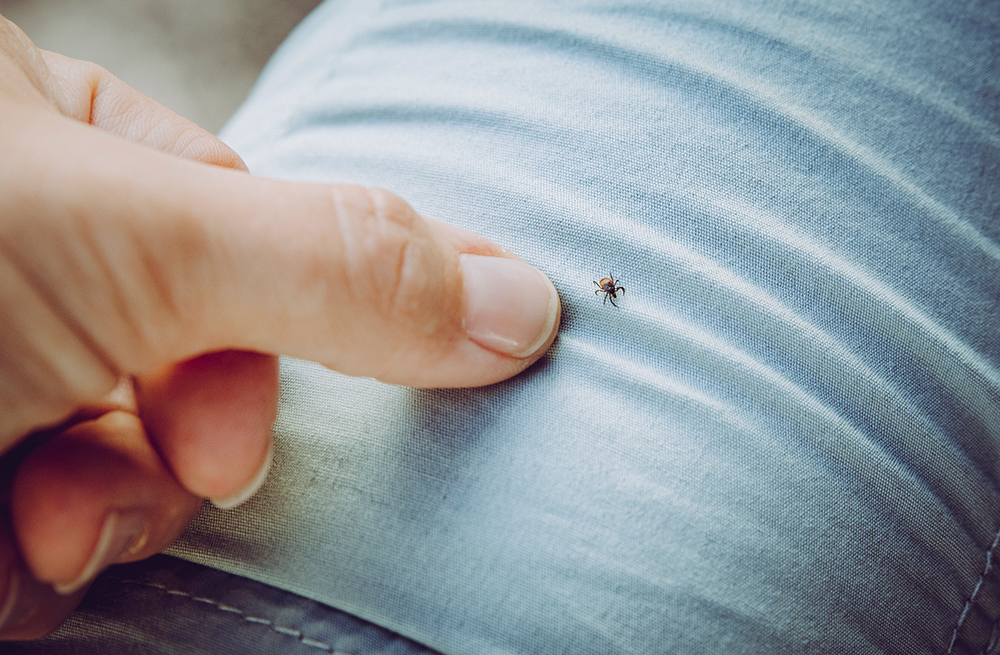Stay Safe From Lyme Disease This Summer
Written By: Suzanne Kvilhaug
When you aren’t feeling well, it can be tempting to turn to Dr.Google for a diagnosis. One summer I wasn’t feeling as healthy as I normally do and began to experience a range of odd symptoms that wouldn’t go away. So naturally after a whole lot of research, I was starting to fear that I had Lyme disease. I live in the Northeast, I run in wooded areas and it would explain how I was feeling. Luckily it wasn’t Lyme, but it did open my eyes to the complexities and severity of the disease.
Lyme disease is quickly spreading across the entire globe - 300,000+ people per year contract it.
According to Quest’s report, 60% of Lyme disease cases occur in the Northeastern United States, with a decided spike in the last few years.
What is Lyme disease?
Lyme disease is an infectious bacterial disease caused by the spiral-shaped bacteria (spirochete) known as Borrelia burgdorferi. There are approximately 300 strains of Borrelia worldwide which instigate varied symptoms and add to the difficulty of testing and diagnosis.
What does a tick bite look like?
If you are bitten by a black legged tick and develop Lyme disease, you may see a bull’s-eye rash. It’s a common sign of Lyme disease, but it’s not the only sign.
Lyme disease occurs in stages. Here’s what you may see on your skin during each stage.
Stage 1: Quickly expanding rash
After being bitten by a black-legged tick, a quickly growing rash can appear. This is the earliest stage of Lyme disease, known as stage 1.
Most people who develop a rash, get it within days or weeks of being bitten by a tick.
Where you see the rash: If you develop a rash, it appears near (or where) the tick bit you. For most people, that means the back, groin, armpit, or a lower leg. However, a tick can bite you anywhere.
What the rash can look like: You may see a spot or bump on the skin, which is the bite mark. Around or near the bite mark, a rash develops. Some people see the bull’s-eye rash.
If you develop a rash during this stage, you may notice that it:
Feels smooth and warm to the touch
Causes a burning sensation
Itches or feels painful
Has an outer edge that feels scaly or crusty
Why do some people not realize they’ve been bit by a tick?
Tick bites that transmit Lyme disease can be really hard to catch. Only about 25 percent of patients who develop Lyme disease recall getting bitten. When a tick bites you, it has an anesthetic in its saliva that actually numbs the surface of your skin so you don’t feel the bite, and that’s why people don’t know that a tick is latched onto them and is biting them.
What are the symptoms of Lyme disease?
Early symptoms of a tick bite include: Headaches, nausea, numbness, muscle aches, extreme fatigue. If Lyme disease goes untreated you can experience symptoms like: Swollen glands, light sensitivity, sound and smell sensitivity, heart palpitations, muscle and joint stiffness, psychological manifestations such as depression, panic attacks, anxiety, and suicidal ideations, twitching of muscles, Bell’s palsy, brain fog, forgetfulness, poor short term memory disorientation, word finding problems, tremors, seizures, blurry vision, vertigo, tingling, numbness, stabbing sensations, chronic cough, sweats, weight loss, weight gain, hormone imbalances, poor digestion, changes in bowel habits, chronic yeast infections, and poor immune function.
How to remove a tick?
What you need: Pointy tweezers (not square tipped tweezers) Rubbing alcohol (or soap and water can work too).
Clean the area around the tick bite with rubbing alcohol.
Get your tweezers right down on your skin so you can grab as close as possible to the tick’s head.
Pull up slow and firm. Don’t jerk or twist; a nice, steady pressure straight up will do.
Clean the bite area again, and your hands, with rubbing alcohol or soap and water.
Shop this top rated tick removal kit here.
How do you get tested for Lyme disease?
CDC currently recommends a two-step process when testing blood for evidence of antibodies against the Lyme disease bacteria. Both steps can be done using the same blood sample.
The first step uses a testing procedure called “EIA” (enzyme immunoassay) or rarely, an “IFA” (indirect immunofluorescence assay). If this first step is negative, no further testing of the specimen is recommended. If the first step is positive or indeterminate (sometimes called “equivocal”), the second step should be performed. The second step uses a test called an immunoblot test, commonly, a “Western blot” test. Results are considered positive only if the EIA/IFA and the immunoblot are both positive.
The two steps of Lyme disease testing are designed to be done together. CDC does not recommend skipping the first test and just doing the Western blot. Doing so will increase the frequency of false positive results and may lead to misdiagnosis and improper treatment.
New tests may be developed as alternatives to one or both steps of the two-step process. Before CDC will recommend new tests, their performance must be demonstrated to be equal to or better than the results of the existing procedure, and they must be FDA approved. For more details, see: Recommendations for Test Performance and Interpretation from the Second National Conference on Serologic Diagnosis of Lyme Disease.
Treatment plans vary for Lyme disease
Doctors most often treat Lyme disease by giving patients antibiotics which are taken over the course of several weeks. Depending on someone’s symptoms, other medications like NSAIDs, corticosteroids and painkillers might be used to control pain and inflammation. The CDC reports that: “Patients treated with appropriate antibiotics in the early stages of Lyme disease usually recover rapidly and completely. Antibiotics commonly used for oral treatment include doxycycline, amoxicillin, or cefuroxime axetil. Patients with certain neurological or cardiac forms of illness may require intravenous treatment with drugs such as ceftriaxone or penicillin.”
Although these medications can help many people to overcome Lyme disease, these prescriptions don’t always work. Long-term antibiotic treatments for Lyme disease have reportedly helped many people recover, but they have also been associated with serious complications and don’t always seem to resolve symptoms better than placebo.
Lyme disease is complicated because symptoms vary greatly from person to person. Try choosing a doctor that designs protocols specifically per patient.
Lyme disease prevention tips
Walk in the middle of trails.
Avoid sitting on logs and leaning on trees.
Wear a hat, tuck in hair if possible.
Wear a long-sleeved shirt fitted at the wrist.
Wear shoes, no bare feet or sandals.
Wear long pants tucked into high socks.
Consider DEET for skin and permethrin for clothes.
Do tick checks immediately and then again 3 days after outdoor activity.
Taking a shower reduces chances of missed ticks as they often travel to warm protected areas of the body.
Try out alternative medicine products like this homeopathic Tick Bite Balance I that prepares the body’s immune system for the tick season.

